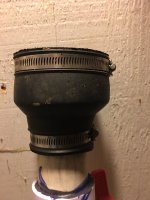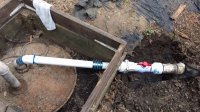Ami.l
New Member
Hi all experts and thanks in advance for your help!
I live in Alameda County in northern CA in a hillside house.
The pipe leading up to the street main sewer line is a 3" PVC, about 400 ft long, with an elevation difference of about 40 ft.
~2 Years ago, I had professional plumbers repair my sump pump float. They also replaced the last pipe section to the pump with a new check valve.
They used a rubber reduction coupling (shown in attached photo) to connect the 3" main pipe to the 2" pump pipe.
Last month, the coupling failed, shifted out of place, causing a spill of the entire pipe content into my back yard. you can do the math, it's ~150 gallons... at ~17.5 PSI...
My question is:
Is this coupling allowed by code to be used on pressurized lines?
I see it (or very similar item) on home depot web site, where it explicitly says this is for DWV: http://www.homedepot.com/p/3-in-x-2-in-PVC-DWV-Mechanical-Flexible-Coupling-P1056-32/100372295
If the plumber did commit a code violation, where is the relevant code section, and what do you think is the extension of the plumber's liability for this spill?
Thank you for your thoughts!
Ami
I live in Alameda County in northern CA in a hillside house.
The pipe leading up to the street main sewer line is a 3" PVC, about 400 ft long, with an elevation difference of about 40 ft.
~2 Years ago, I had professional plumbers repair my sump pump float. They also replaced the last pipe section to the pump with a new check valve.
They used a rubber reduction coupling (shown in attached photo) to connect the 3" main pipe to the 2" pump pipe.
Last month, the coupling failed, shifted out of place, causing a spill of the entire pipe content into my back yard. you can do the math, it's ~150 gallons... at ~17.5 PSI...
My question is:
Is this coupling allowed by code to be used on pressurized lines?
I see it (or very similar item) on home depot web site, where it explicitly says this is for DWV: http://www.homedepot.com/p/3-in-x-2-in-PVC-DWV-Mechanical-Flexible-Coupling-P1056-32/100372295
If the plumber did commit a code violation, where is the relevant code section, and what do you think is the extension of the plumber's liability for this spill?
Thank you for your thoughts!
Ami


